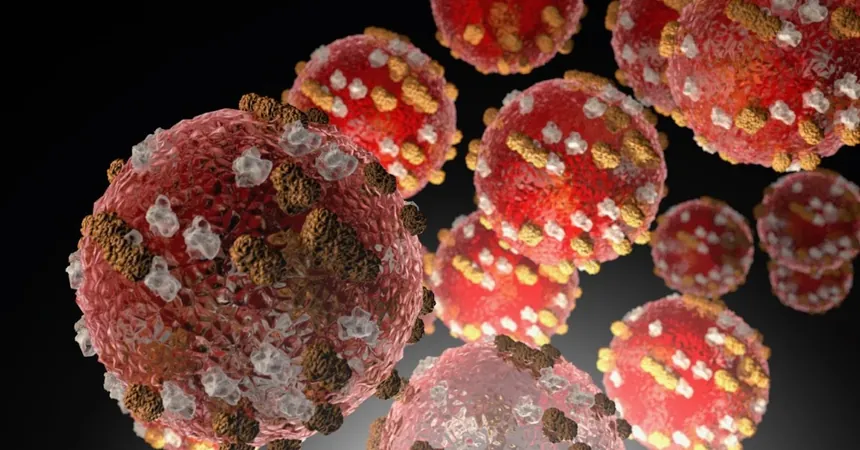
From Knee Pain to a Rare Cancer Diagnosis: An Army Veteran's Battle for Life
2025-01-25
Author: Yan
Introduction
In a gripping tale of resilience, U.S. Army Staff Sgt. Rayshaun Smith's story highlights the unexpected challenges faced by veterans. During his 2018 deployment in South Korea, what began as mild knee pain soon spiraled into a life-altering diagnosis. Initially chalking it up to the rigors of military life and strenuous workouts in demanding terrain, Smith believed his discomfort was just part of the job.
"I thought it was just everyday pain," Smith, now 32, recalled. For years, he managed the discomfort with over-the-counter pain relief. However, in 2020, while working in recruitment stateside, the pain became too persistent to ignore, prompting him to seek the expertise of an Air Force doctor.
Unexpected Diagnosis
This medical journey took a surprising turn when a physical therapist's assessment redirected suspicion toward Smith's hip rather than his knee. Further consultations led him to an orthopedic oncologist, whose shocking diagnosis revealed a rare grade 3 sarcoma nestled within his pelvis. The news was devastating. “It was terrifying,” Smith recounted. “I got to work and told my supervisor. He told me to just go home.”
The prognosis suggested amputation of the cancerous portion of his pelvis, which would mean losing a leg. However, fate intervened when Smith was referred to the Cleveland Clinic, where Dr. Nathan Mesko, a leader in orthopedic oncology, unveiled a groundbreaking alternative. Mesko’s innovative approach involved utilizing cutting-edge 3D printing technology to create a custom implant that would allow Smith to retain his leg while effectively removing the cancer.
Understanding Sarcoma
Dr. Mesko explained that sarcomas account for a mere 1% of adult cancers but are particularly aggressive, with pelvic variants often going unnoticed until they grow large due to their location. Smith's experience with "referred pain" – where discomfort appears in one area while originating from another – explained why he initially misidentified his condition.
Surgery and Recovery
The complexity of Smith’s surgery, estimated to take between six to ten hours, raised concerns about potential complications such as infections or blood clots. Yet, in the face of fear, Smith’s bravery shone through. When Dr. Mesko laid out the extensive procedure, Smith's unexpected calmness was notable. “At the end, he looked at me and said, ‘Alright, when are we going to get started?’” Mesko reflected.
The surgery was a lengthy endeavor, but the outcome was successful. Transitioning to recovery proved challenging; Smith spent ten days hospitalized, followed by rehabilitation to regain his lost mobility and independence. Despite frustrations, he maintained a hopeful attitude. "Now, I’m good physically," he shared, although he still struggles with activities like running.
Facing Recurrence
In 2022, a recurrence of sarcoma surfaced – this time on his femur. However, early detection allowed for a much simpler procedure, necessitating just one night in the hospital. Reflecting on these trials, Smith admitted, “It was terrifying, but recovery wasn't bad.”
Conclusion
Smith’s journey underscores the importance of vigilance and early detection in cancer cases, which remains critical for everyone, not just veterans. Today, he continues regular monitoring every three months, embraced by a supportive medical team prepared for any future challenges.
As he faces his journey with renewed hope, Rayshaun Smith sums it all up perfectly: “I’m just happy to be alive.” Through his tenacity and the innovative treatments available today, he stands testament to the spirit of survival against all odds, reminding us all of the fragile yet resilient nature of life.




 Brasil (PT)
Brasil (PT)
 Canada (EN)
Canada (EN)
 Chile (ES)
Chile (ES)
 Česko (CS)
Česko (CS)
 대한민국 (KO)
대한민국 (KO)
 España (ES)
España (ES)
 France (FR)
France (FR)
 Hong Kong (EN)
Hong Kong (EN)
 Italia (IT)
Italia (IT)
 日本 (JA)
日本 (JA)
 Magyarország (HU)
Magyarország (HU)
 Norge (NO)
Norge (NO)
 Polska (PL)
Polska (PL)
 Schweiz (DE)
Schweiz (DE)
 Singapore (EN)
Singapore (EN)
 Sverige (SV)
Sverige (SV)
 Suomi (FI)
Suomi (FI)
 Türkiye (TR)
Türkiye (TR)